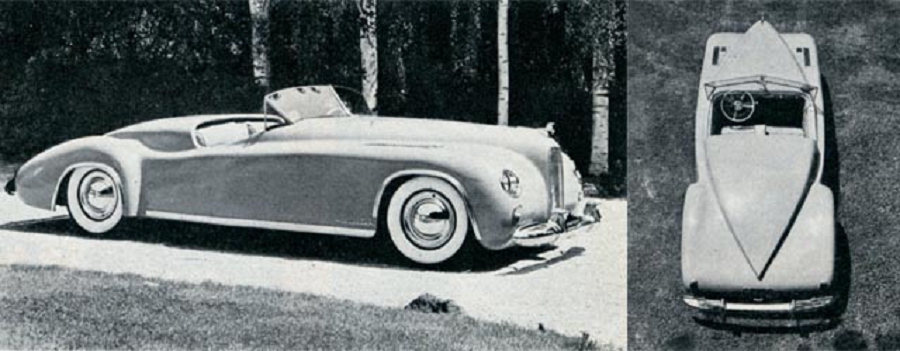
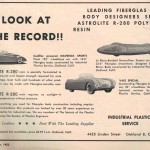
Here the Maverick Sportster Is Shown In An Ad For “Industrial Plastics Service” in the November 1953 Issue of Hop Up Magazine. To Date, This Is The Only Ad Showing A Maverick We’ve Found.
Hi Gang…
You gotta love the Maverick Sportster from 1952….
It’s a good looking, graceful, and sophisticated design that grabs you the moment you see it. If fact, it fits a definition of “good looking” that fiberglass friend Robert Cumberford wrote about in the March 1960 Sports Car Guide magazine years ago.
In his column called “From the Drawing Board”, Cumberford says:
“In months to come, this column will be devoted to critical analysis of sports car design – from the outside in. It is my firm belief that to be worthy of the name, a sports car must first of all be good looking. Let me enlarge a bit by giving my own definition of just what “good looking” means: a good looking car is one whose visual presence commands some sort of emotional response. The modest, bland, contemporary nonentity, product of the designer’s failure of nerve, must be condemned along with the excessive and gaudy product of his failure of taste.”
I have an emotional response when I take in the full beauty of the Maverick’s design. Now, Robert may not agree that his definition of “good looking” applies to the Maverick, but it certainly fits my definition. But then again, I really like cars that make a visual impact, are styled well, and large in size. Think “Blastolene” and you’ll know what I mean (click here to learn more about the Blastolene cars).
Let’s turn our attention to Maverick and review some of the early history on this car.
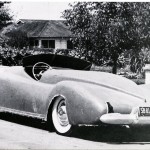
This Image Appears in the 1955 Fiberglass Book by John Wills And Shows One Of The First Maverick Sportster Fiberglass Bodies.
Modern Plastics: October 1953
The Maverick was designed and built by Sterling Gladwin, Jr., an aeronautical engineer by training who worked with Lockheed and who’d been a hot rodder long before World War II. His inspiration for the “Maverick” was a 1933 Essex Terraplane boattail speedster. We’ll talk in detail about the Maverick in future stories, but today I want to introduce you to early articles that are important to the history of the car for different reasons. The first article is from the technical trade journal: Modern Plastics.
Modern Plastics Magazine published their first monthly edition in 1925, and quickly became the trade journal of choice for the technical side of the plastics industry. From time to time I’ve featured articles about fiberglass cars from this magazine because they are geared toward the “professional” side of fiberglass – not the “enthusiast” side. As such, the perspective and information they review is absolutely different and often presents new details. Rick D’Louhy and I feel that sources of information such as these are critical to documenting the history of vintage fiberglass cars – from every perspective possible.
I’ve re-typed the article, below, and posted a scan of it in the gallery of pictures. As you review the article, you’ll notice much more technical jargon – given the technical nature of the journal. That is, you’ll see phrases such as “bodies of fibrous glass-polyester laminates.” You’ll have to just enjoy this new way of talking about fiberglass cars. Maybe you can use the new jargon you’ll see in a sentence such as
“I wonder how Guy Dirkin is doing on the restoration of his Victress body of fibrous glass-polyester laminates?”
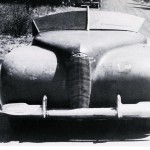
Another Early Picture of the Maverick From The John Wills Book. Here It Looks Like They Are Working On Alternate Headlight Treatments.
I like it already! Here’s the article:
Sports Car Body is 16 Feet Long
Interest among motorists in custom-made automobile bodies of fibrous glass-polyester laminates continues to grow – and the number of such bodies in commercial production continues to multiply at an amazing rate.
One of the latest entries in this new market is a sleek sports model being manufactured by Maverick Motors, Mountain View, California. The streamlined reinforced plastics body of the Maverick measures 16 feet long and 6 feet wide, yet weighs only 220 pounds. It is designed to fit any Cadillac sedan chassis, dating back to the 1936 model, and can also be adapted to fit Hudson, Packard, Buick, and Chrysler frames with a 120 to 128 inch wheelbase.
Except for the hood, the body is molded in one piece with no connecting panels or joints to break the sweep of its curves. Instead of a hinged trunk door, the seat cushions swing forward to provide access to the automobile’s luggage compartment.
In the production of both the female mold and the plastics body, the reinforcing Fiberglass is impregnated with Astrolite compounds formulated from Bakelite polyester resins by Industrial Plastics & Chemicals, Oakland, California.
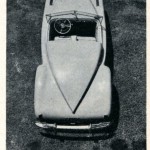
I’ve Always Liked The Overhead Views Taken Of The Maverick. This Was One Of The Last – If Not The Last – Boattail Speedster Made In America.
The male master was built up of 1400 lbs of plaster formed over a framework of Masonite and steel tubing. When the plaster surface had been brought to a smooth finish, the female production mold was made on it by laying up impregnated cloth and mat.
Production of the final body is similar to that of the female mold. Parting agents and polyester resins are applied to the surface of the cured female mold and glass cloth or mat is laid on this surface, impregnated with polyester resins, and cured.
After curing, the shell is attached to the chassis by four bumper brackets and two main body bolts on each end of the front fender. The body carries no accessories except lights and windshield; instrument panel and upholstery are integral with chassis.
Key Thoughts on Article:
Several points concerning this article are of note:
* The Maverick was built to fit on any Cadillac sedan back to 1936. Given that the Cadillac overhead valve engine came out in 1949, a newer chassis/drivetrain would have been better – but much more expensive to obtain in 1952. The choice of an older chassis make financial sense.
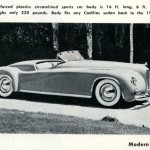
Here The Caption Reads, “Reinforced plastics streamlined sports car body is 16 feet long, 6 feet wide, and weights only 220 pounds. Body fits any Cadillac sedan back to the 1936 model.” That Was Just 17 Years Early (for the chassis, that is).
* Correctly stated at the time, the Maverick Sportster was the largest production fiberglass body produced for sports cars in the 1950’s. The wheelbase is 127”. For comparison, a Victress S1A Roadster is 99”. This is one big car gang!
* The company mentioned – Industrial Plastics – also produced the Vale bodies from the same era (1952-1953), and the famous “Le Blanc-Bardahl Streamliner” which was one of the fastest cars in the world in 1953.
Some interesting stats gang! Impressive information for an impressive car.
1955 Glass Fiber Auto Body Construction Simplified – By John Wills
I found more information in a 1955 book by John Wills. His first edition of this book was published in 1952, and by 1955 this was the third edition, and contained the most pictures of any book of his up to that point.
The 1955 book was printed and distributed by Post Publications of Arcadia California, and in this book, John Wills shows the Maverick under development. An early fiberglass Maverick body is shown as an example of a car in the process of being built and designed.
I’ve included some pictures of this early Maverick in the gallery of photos below. What’s interesting is you can see that they were still working out the headlight configuration and you can see a teardrop shaped outline on the passenger side of the car for a late 1930’s headlight lens. Pretty neat!
The “Smoking Gun”: Oakland Tribune, Sunday August 24th, 1952
As I’ve mentioned in several previous “Forgotten Fiberglass” stories, Rick and I set the bar very high in determining both beginning and end dates for each of the fiberglass companies we study. In reviewing newspaper archives for 1952 and later, we found the “debut” of the first Maverick body discussed as follows:

This Image Appears in the 1955 Fiberglass Book by John Wills And Shows One Of The First Maverick Sportster Fiberglass Bodies.
Along Auto Row:
Oakland Produces Plastic Car Body
By Homer D. Fey, Tribute Auto Editor
Fiberglas-Plastic Car
The largest fiberglas-plastic sports car body yet constructed, according to the manufacturers, was produced recently by the Industrial Plastics Service at 4425 Linden Street. It was constructed of Astrolite liquid plastics, reinforced by Fiberglas manufactured by Owens-Corning Fiberglas Corporation, and was built especially for Maverick Motors of Mountain View and will become standard equipment for the Maverick sports car.
The “largest Fiberglas-plastic sports car body yet constructed,” is designed to fit 123”-125” wheelbase cars – the overall length is 16’ and width 6’. Weight approximately 220 pounds. The Maverick Company does a complete job of rebuilding V-8 LaSalle cars. Engine is re-bored to standard Cadillac size, special grind three-quarter race cam, Edmunds heads, Mallory ignition, dual exhaust, etc.
Steering and suspension have been redesigned and the car has a low center of gravity with 7 and ½” of ground clearance. Engine develops 207 horsepower at 3600 rpm and it is claimed the cars have a cruising speed of 110 mph. It is planned to market the Maverick sports car complete for $3000.
Our place in this picture is as follows: J. Fraser Rae is the owner of Industrial Plastics Service, and has been associated with the plastics industry in the capacity of technical consultant and instructor for over twenty years.
I’m in the process of trying to locate the J. Fraser Rae family. Hopefully, if I find them, they will have added information concerning their father’s company that we can discuss and review here at “Forgotten Fiberglass.”
Summary:
The Maverick is one neat car. Approximately 7 to 12 of these cars were built in the 1950’s. So far, we’ve only found completed factory cars, but time will tell if any “kits” are found to have been built.
What’s also interesting about this company is that I we’ve found brochures for “Maverick Motors” but not one stick of advertising in a magazine or newspaper. This is not as uncommon as you might think. The same is true for Grantham Stardust, LaSaetta, Rockefeller Yankee, and several other companies of the era. It seems that the magazine articles themselves (which often published how to contact the companies being reviewed) was information enough to go into business.
Hope you enjoyed the story, and until next time…
Glass on gang…
Geoff
——————————————————————–
Click on the Images Below to View Larger Pictures
——————————————————————-
- Here The Caption Reads, “Reinforced plastics streamlined sports car body is 16 feet long, 6 feet wide, and weights only 220 pounds. Body fits any Cadillac sedan back to the 1936 model.” That Was Just 17 Years Early (for the chassis, that is).
- I’ve Always Liked The Overhead Views Taken Of The Maverick. This Was One Of The Last – If Not The Last – Boattail Speedster Made In America.
- This Image Appears in the 1955 Fiberglass Book by John Wills And Shows One Of The First Maverick Sportster Fiberglass Bodies.
- Another Early Picture of the Maverick From The John Wills Book. Here It Looks Like They Are Working On Alternate Headlight Treatments.
- Here the Maverick Sportster Is Shown In An Ad For “Industrial Plastics Service” in the November 1953 Issue of Hop Up Magazine. To Date, This Is The Only Ad Showing A Maverick We’ve Found.

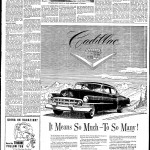
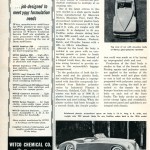
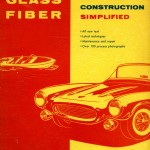
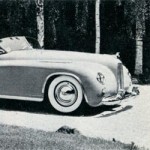
This is a great site,I love all of those vintage fiberglass cars.Talk about pioneers,wow! They are things of beauty,in there own way.Keep up the great job.